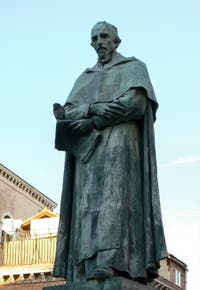History Important dates | Politics | Navy | Love | Wars | Religion | Scuole | Ghetto | Printing
Religion Paolo Sarpi |
Sarpi Brother Paolo | Excommunication | Protesto
On May 6th, 1606, Venice publishes the “Protesto”
Protesto shows that papal ultimatum is against the Scriptures of the fathers of the Church and to the Sacred Canonics, and declares it “null and void”.Venice asks the Pope to acknowledge the worthlessness and the harm done on her.
By the Protesto showing the error of the Pope, his sentence does not have importance any more and the priests must operate their offices normally.
Venice do not hesitate to utilize the police force and to threaten with death convince the priests who would refuse to say the mass.
There will have no executions, only imprisonments, and the expulsion of the Jesuits.
From the point of view canonical, all these measures absolve the priests who obey the Republic.
French Intervention
Pressures and pontifical threats being ineffectual, the war was the last solution to put an end to this humiliation.And Venice must commit considerable expenses to support a battle fleet ready to confront a possible Spanish and Roman attack.
But the risks of destabilization causes Spain to retreat.
The King of France intervenes by offering to send the Cardinal of Joyeuse (in South of France) to act as mediator between Venice and the Vatican.
On April 21st, 1607, Venice returned both Ecclesiastics to the Ambassador of France
Venice makes clear that she is doing it out of regard for King Henri IV who respects the right of the Venetians to judge the ecclesiastics.The Ambassador returns them to the Cardinal of Joyeuse, who returns them to the Nuncio of the Pope.
As a result the Pope lifts the Excommunication and the Doge revokes Protesto, but not laws concerning the ecclesiastical property which he contents himself with suspending provisionally.
This diplomatic exit does not satisfy Paul V who thinks that for a true remission of its sins, Venice must accept solemn absolution.
Refusal of Venice which sees there an implicit recognition of its share of the censures that it had pushed back without concession, sure to be right…
It seems that the Cardinal of Joyeuse will obey the Pope by mumbling the expression of absolution and blessing “on the sly” the Senate during his reception.
Win of the Sovereign State
For Rome, the Doge Leonardo Donà and the Brother Paulo Sarpi had drawn away Venice in heresy and all this debate had blunted the weapon of ban to say mass and to give sacraments to those who do not submit to her authority by divine right.Because of Sarpi!
The problems caused by Sarpi and by the theologians who had helped him had to be solved in Rome, where they were summoned under threat of excommunication. Fearing Paul V’s revenge, Venice keeps Sarpi under its protection.A Brother who went to the summoning to explain himself will be burned at the stake. One or two others theologians think fit to retract, but not Brother Paulo Sarpi who persists and signs.
Venice, New Geneva and Center of Subversion
Contrary to what certain Prelates thought, Venice was far from being a “nest of heretics” likely to give the bad example which should be hailed as fast as possible.Even if Sarpi had maintained relations with known Protestants, and even if the Ambassadors of the Protestant countries had used it to make a bit of proselytizing, neither he nor the Venetians had any intention of converting.
The Venetian government only made a point of remaining Master of their own place: “The Venetians do not have their Pope in Rome, but in Saint-Mark, in Papa Marco.”

Pierre Paolo Sarpi
Rather Uncharitable Revenge
The evening of October 5th, 1607 Paolo Sarpi is attacked on the Bridge of Santa Fosca by a band of assassins paid by Rome, wounded by several stylet stabs and left for dead.With his habitual irony, he said to those who rescued him: “I recognize the style (stylet) of the Roman Curia here!”.
As the Cardinal Bellarmin had warned him before the attack; it seems that Fra Paolo had taken precautions by wearing a coat of mail under his ecclesiastical dress…
Sarpi spent the rest of his life in a convent, sheltered from the murderers.
He wrote the History of the Council of Trent in 1619 but not without a critical eye.
Brother Paolo Sarpi Honored as a Doge
Paolo Sarpi dies in 1623. The Senate asks the Ambassadors having a post in Venice to announce his death to all Sovereigns of Europe, an honor which was granted only to the Doge.He was buried in the church of Servites.
The statue of Brother Paolo Sarpi is on the Campo Santa Fosca (Cannaregio).
Sarpi Brother Paolo | Excommunication | Protesto
Religion Paolo Sarpi |
History Important dates | Politics | Navy | Love | Wars | Religion | Scuole | Ghetto | Printing
Back to Top of Page

